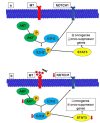Melatonin's Antineoplastic Potential Against Glioblastoma
- PMID: 32138190
- PMCID: PMC7140435
- DOI: 10.3390/cells9030599
Melatonin's Antineoplastic Potential Against Glioblastoma
Abstract
Glioblastoma (GBM) is one of the most intransigent and aggressive brain tumors, and its treatment is extremely challenging and ineffective. To improve patients' expectancy and quality of life, new therapeutic approaches were investigated. Melatonin is an endogenous indoleamine with an incredible variety of properties. Due to evidence demonstrating melatonin's activity against several cancer hallmarks, there is growing interest in its use for preventing and treating cancer. In this review, we report on the potential effects of melatonin, alone or in combination with anticancer drugs, against GBM. We also summarize melatonin targets and/or the intracellular pathways involved. Moreover, we describe melatonin's epigenetic activity responsible for its antineoplastic effects. To date, there are too few clinical studies (involving a small number of patients) investigating the antineoplastic effects of melatonin against GBM. Nevertheless, these studies described improvement of GBM patients' quality of life and did not show significant adverse effects. In this review, we also report on studies regarding melatonin-like molecules with the tumor-suppressive properties of melatonin together with implemented pharmacokinetics. Melatonin effects and mechanisms of action against GBM require more research attention due to the unquestionably high potential of this multitasking indoleamine in clinical practice.
Keywords: antineoplastic effect; glioblastoma; melatonin.
Conflict of interest statement
The authors declare no conflicts of interest.
Figures


References
-
- Ostrom Q.T., Gittleman H., Liao P., Vecchione-Koval T., Wolinsky Y., Kruchko C., Barnholtz-Sloan J.S. CBTRUS Statistical Report: Primary brain and other central nervous system tumors diagnosed in the United States in 2010–2014. Neuro. Oncol. 2017;19:v1–v88. doi: 10.1093/neuonc/nox158. - DOI - PMC - PubMed
Publication types
MeSH terms
Substances
LinkOut - more resources
Full Text Sources

